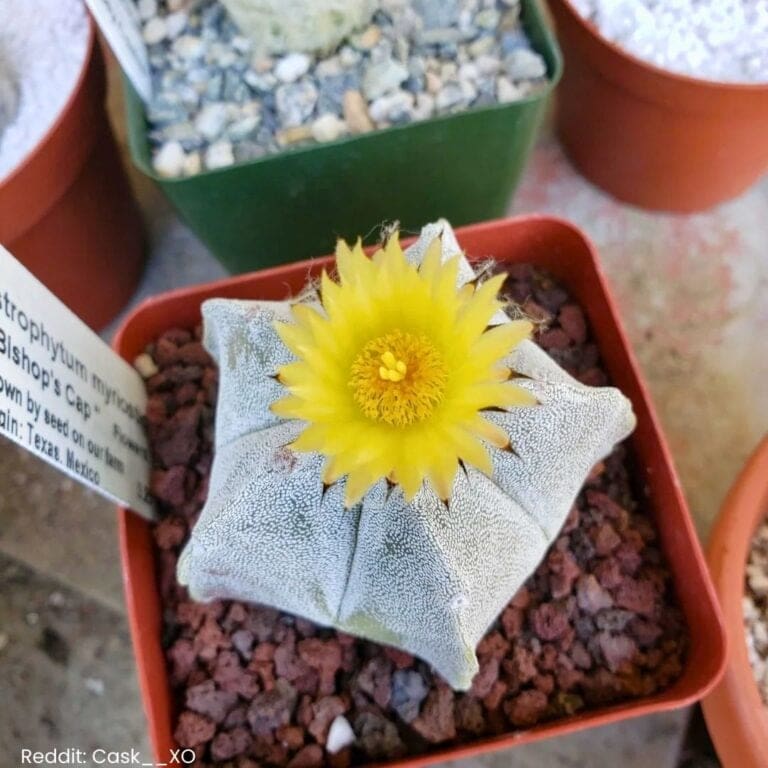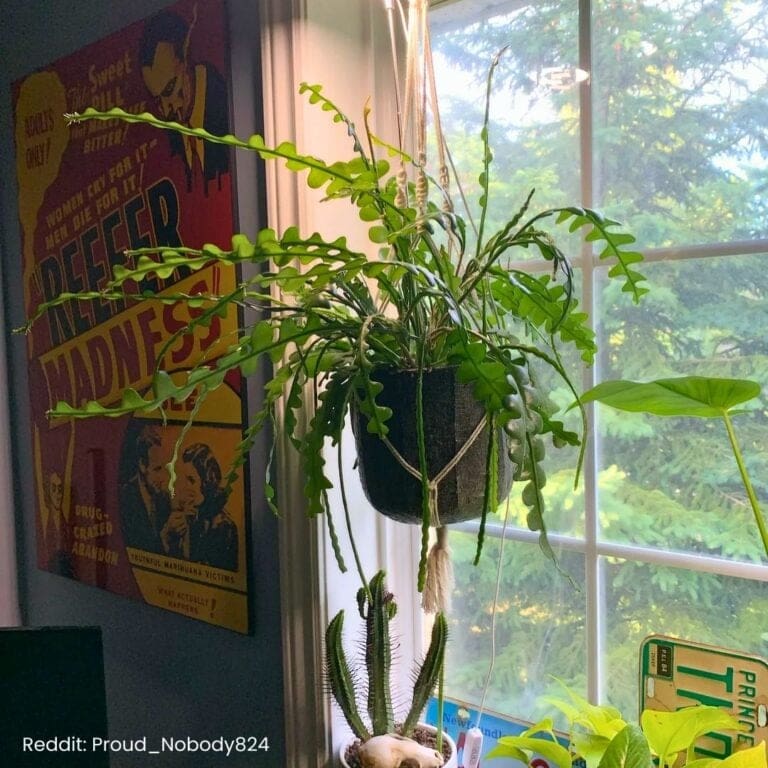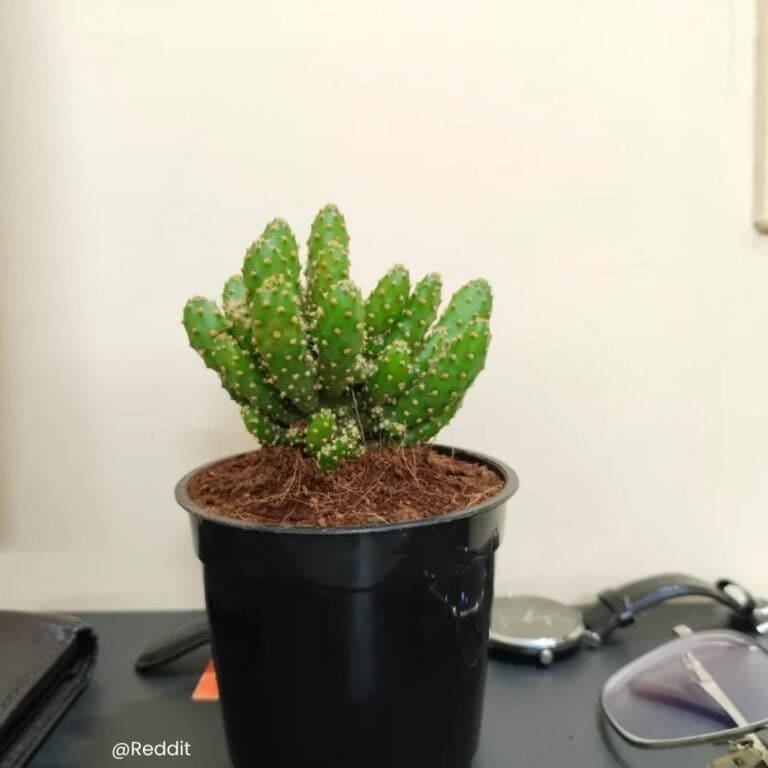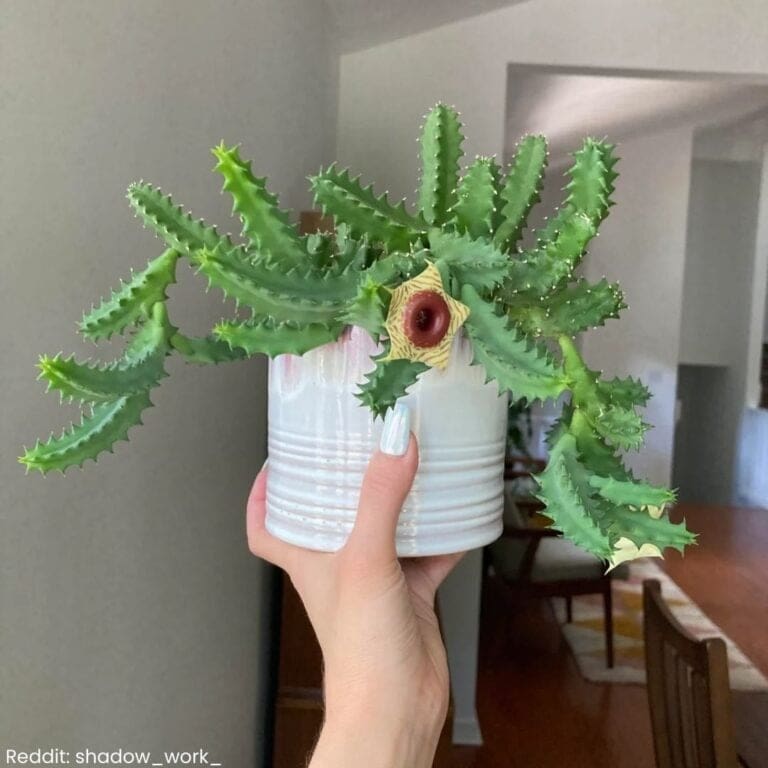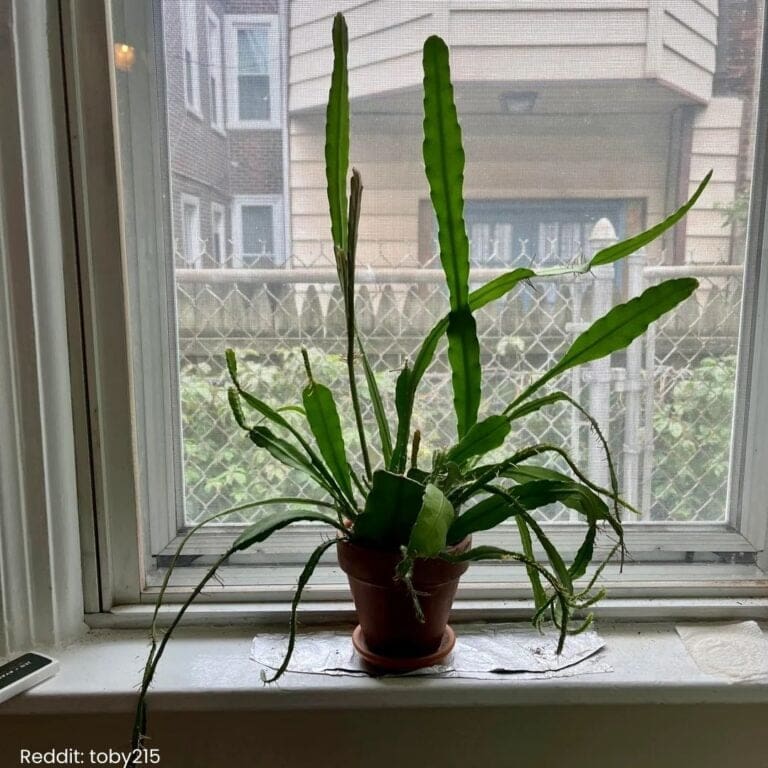How to Care for Ladyfinger Cactus?
Caring for a ladyfinger cactus is easier than you might think! 🌵
These little plants are perfect for anyone who loves low-maintenance greenery.
The key to keeping them happy is ensuring they get plenty of sunlight and minimal water.
Imagine having a plant that thrives even when you forget to water it! Sounds perfect, right?
I’ve found ladyfinger cacti to be the ideal companions for my busy lifestyle.
They have a unique charm with their finger-like stems and cute little spines. Plus, they’re a great conversation starter.
Ever had guests marvel at your mini desert garden? It’s fun and makes your space feel lively.
Curious about how to keep your cactus looking its best?
Let’s dive into selecting the right soil, creating a cozy spot with just the right light, and knowing exactly when to give it a drink. 🌞
Your cactus will thank you with its quirky beauty, and you’ll enjoy a hassle-free plant companion!
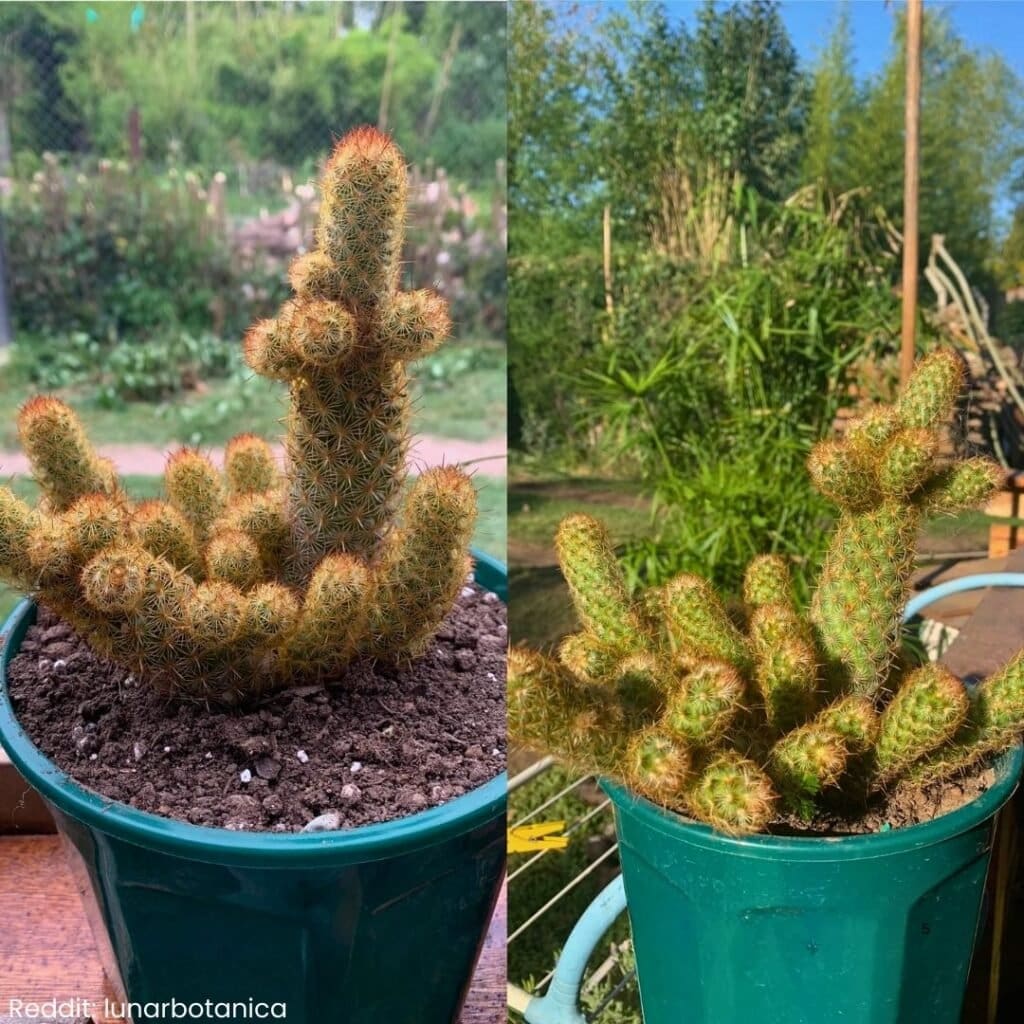
Please note: Simplify Plants is reader-supported. As an Amazon Associate, I earn from qualifying purchases made by our readers with no extra cost added to you all! Some links in the post are affiliate links and I get a commission from purchases made through links in the post.
Getting to Know Ladyfinger Cactus
Ever seen a plant that looks like it’s waving tiny fingers at you? That’s the ladyfinger cactus! Let’s explore its unique features and where it calls home. 🌵
Description and Characteristics
The ladyfinger cactus, also called Echinocereus pentalophus, is a delightful small cactus.
It has slender stems that look just like fingers. These stems are green with white spines, which makes them easy on the eyes.
Imagine a group of green fingers catching the sunlight, sometimes topped with bright pink flowers. 🌸
This plant grows in clumps, often spilling over its pot. It’s not just pretty; it’s also tough. I mean, it’s a cactus!
Ladyfinger cacti need low maintenance and have minimal water needs. You won’t find it begging for water every day.
It’s perfect for anyone who forgets to water their plants sometimes. Do any of us do that? 😅
Native Habitat
You can find the ladyfinger cactus in northern Mexico and parts of the southern United States, like Texas. It loves dry, rocky places.
It’s like the desert’s little superstar! ⭐
These areas are ideal because they’re sunny and dry—perfect for a cactus.
In these spots, the cactus soaks up the sun but gets little rain. It’s great at storing water just in case.
That’s why it’s a champ at surviving in tough spots. Nature sure knows how to design a perfect plant for harsh conditions!
Have you ever visited a desert and seen cacti in their natural setting? It’s pretty amazing to see these survivors in action!
Essentials of Ladyfinger Cactus Care
Caring for a ladyfinger cactus is a rewarding task. 🌵
This plant loves sunlight and needs a careful watering routine. Let’s dive into how the right temperature and humidity make it thrive.
Sunlight Requirements
My ladyfinger cactus thrives with plenty of sunshine.
I usually place it where it can soak up the sun for at least 6 hours a day.
The best spot? Near a sunny window. This keeps it happy and growing strong.
Just a tip—rotate the cactus now and then. This way, each side gets sun and stays even in growth.
Watch out for any signs of sunburn.
If the cactus starts looking pale or scorched, it may be getting too much direct sunlight.
A sheer curtain can soften this light and protect it. 🌞
Watering Guidelines
Here’s the golden rule I follow: less is more.
Over-watering is a no-no. I let the soil dry out between waterings.
Usually, once every two weeks works well for me, especially during the growing season.
In winter, my watering schedule changes to once a month or less.
It’s their resting period, and the ladyfinger cactus needs less water.
I make sure the pot has drainage holes. This prevents water from collecting at the bottom and keeps the roots healthy.
Ideal Temperature Range
Ladyfinger cacti love warmth. The ideal range is from 60°F to 85°F.
If it’s too cold, like below 50°F, I move my cactus indoors to keep it cozy and happy.
This range keeps it thriving without stress.
Cold drafts can affect their health.
I avoid placing the cactus near windows with chilly air leaks.
If you have an air-conditioned house, it’s best to keep the cactus away from vents, too.
Warmth makes it feel at home, just like in its native desert. 🌵
Humidity Preferences
The ladyfinger cactus enjoys a dry atmosphere. High humidity isn’t its favorite thing.
I usually keep mine in an area with low humidity—around 30% to 50% is ideal.
Have you ever tried using a dehumidifier? It’s a handy tool if you live in a moist area.
Remember, the native habitat of the ladyfinger cactus is quite arid.
If I notice any moisture-loving company like mold, I reduce the humidity. This ensures a happy and healthy cactus in its preferred environment.
Who knew being dry could be so fun? 😊
Soil and Fertilization

Caring for a ladyfinger cactus involves using the right soil mix and fertilization routine to ensure it thrives.
A well-draining soil mix and a balanced approach to feeding are essential for healthy growth. Let’s dig into the specifics! 🌵
Soil Composition
The ladyfinger cactus loves well-draining soil.
I usually go for a mix that includes sand, perlite, and potting soil. This mix keeps water from sticking around too long.
Who wants soggy roots? Not this cactus! 🚫💧
A good rule of thumb is to aim for about 50% sand or perlite. This ensures drainage is spot-on.
You can find commercial cactus mixes or make your own at home.
Sand helps with drainage, while potting soil provides some nutrients.
When planting, I like to ensure the pot has drainage holes. This is super important because it prevents water buildup, which this cactus dislikes.
Make sure to check the soil regularly to avoid overwatering.
Moisture meters are a handy tool if you’re unsure!
If you enjoy a fun DIY challenge, create your own mix at home, customizing it to the cactus’s needs.
Fertilizing Needs
Feeding my ladyfinger cactus is a breeze!
I use a balanced liquid fertilizer.
Only feed during the growing season, usually in spring and summer.
During these seasons, the cactus is more active and will use the extra nutrients to grow.
I water the cactus first to protect its roots, then I mix the fertilizer according to the package’s instructions.
Less is more here, so dilute to avoid fertilizer burn.
Folks often ask: how often?
I fertilize my cactus about once a month when it’s growing.
In fall and winter, I usually kick back and let the cactus rest without fertilizing.
It’s like giving it a vacation! 🏖️
Keep in mind, over-fertilizing can do more harm, so keep things light and breezy.
If you’re new to cacti, a cactus-specific fertilizer can be a great starting point.
Have you tried fertilizing your cactus yet? 🌟
Potting and Repotting
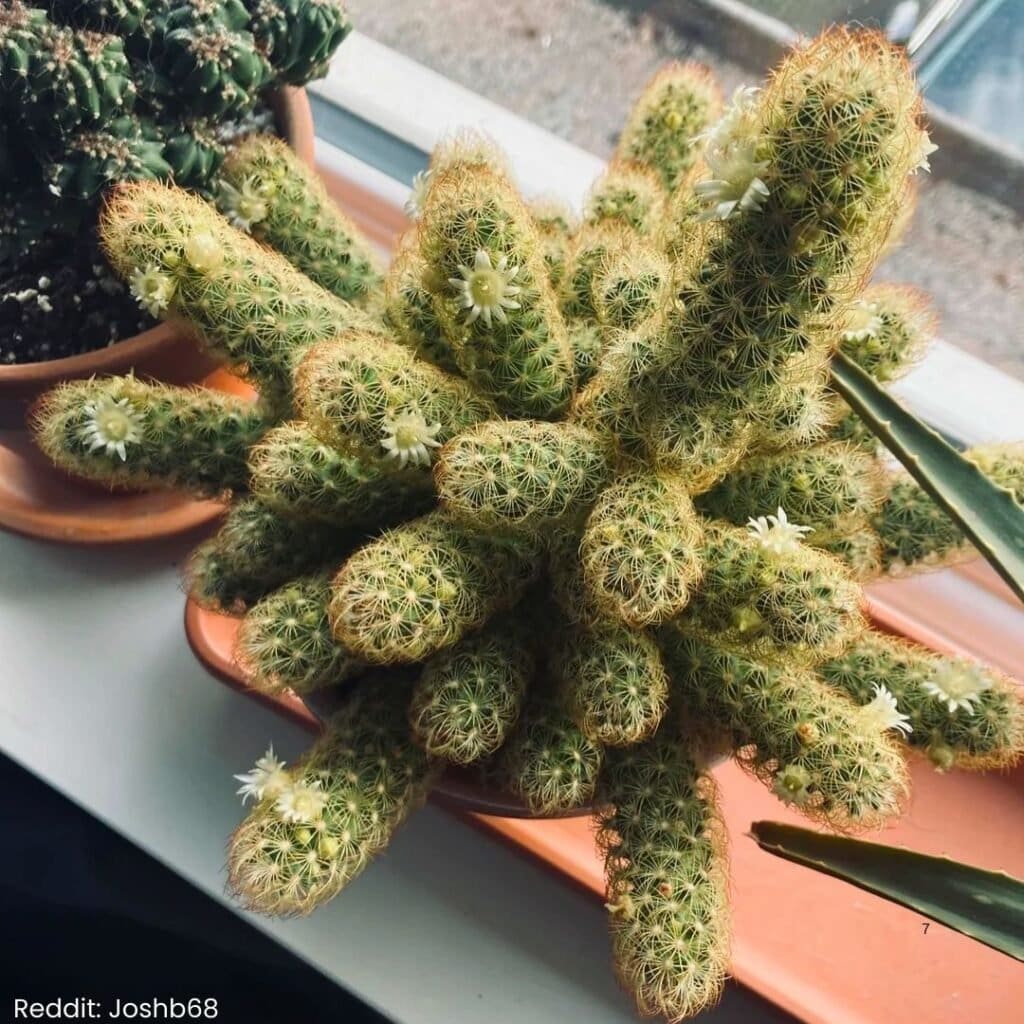
When caring for a ladyfinger cactus, it’s important to use the right pot and know when to repot.
Picking a suitable container and following proper repotting steps ensures your cactus stays healthy and thrives. 🌵🔄
Choosing the Right Container
Finding the perfect container is key!
I always look for one with drainage holes. These prevent water from staying in the pot, which can harm the cactus.
A terra cotta pot is a great choice because it helps with airflow and evaporates extra moisture.
Size matters, too. Pick a pot just a bit larger than the cactus. This helps avoid too much soil, which stays wet longer.
No one likes soggy roots, right? 😅
Consider the pot’s depth. The ladyfinger cactus doesn’t need a deep pot.
Keep it shallow to help the roots grow well without water hiding at the bottom.
Repotting Instructions
Repotting a ladyfinger cactus might sound tricky, but I promise it’s not!
First, I make sure the soil is completely dry.
Gently remove the cactus from its old pot. Be careful—you don’t want to poke yourself with those spines!
After that, I shake off old soil and check for any sick or dead roots. Prune them away if needed.
Next, I put fresh cactus-friendly soil in the new pot, placing the cactus in at the same level as before.
Finally, I wait a few days to water. This allows any cuts on the roots to heal, preventing root rot. 🌱
Have you ever repotted a cactus before? Let me know! 🙋♂️✨
Propagation Techniques
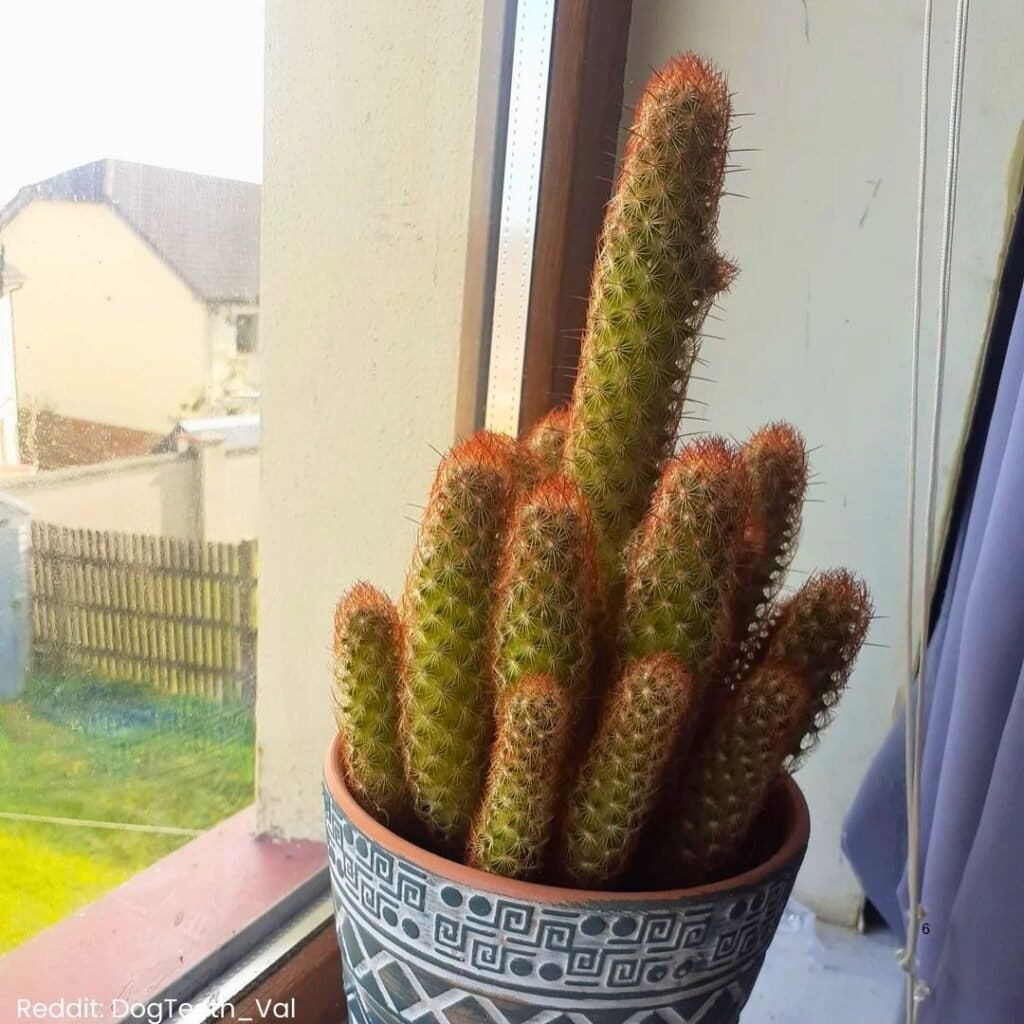
Growing new ladyfinger cacti can be fun and rewarding. You can start from seeds or use cuttings. Both methods offer different experiences and results.
Let’s explore these techniques so you can see which suits you best. Ready to get your hands dirty? 🌵✨
Seed Propagation
Using seeds is a great way to start new plants.
First, I like to soak seeds in water for a few hours to help them sprout faster.
Then I prepare a pot with well-draining cactus soil. It’s important to choose a shallow pot with drainage holes.
After placing the seeds on the soil, I cover them lightly with more soil.
Gentle watering is key—using a spray bottle works well. The pot then goes in a warm, sunny spot.
Seeds take time to grow, sometimes several weeks.
Keep the soil slightly moist but not wet, or the seeds might rot. Check on them regularly.
You’ll feel such a thrill when you see the first tiny cactus appear! 🌱
Cuttings
Ever tried using cuttings? It’s quicker and can be super satisfying.
First, I cut a healthy stem with a clean knife. Make sure it’s not too short—around four inches is perfect. Remember to be careful with the spines!
Next, I let the cut end dry out and callous for a few days. This helps prevent rot when it’s planted.
After that, it’s time to plant the cutting in a pot with well-draining soil.
Firmly place the cutting about an inch deep in the soil. Then, water it lightly and find it a warm spot with plenty of indirect sunlight. 🌵
Did you know cuttings can take root in just a few weeks? Keep an eye on it, and don’t forget to keep it happy with a little water and lots of love. ☀️❤️
Common Issues and Solutions

Caring for a ladyfinger cactus can sometimes be tricky. Let’s look at the challenges such as pest infestations, disease, and water-related problems.
Pest Infestations
You may find pesky bugs like mealybugs and spider mites loving your cactus as much as you do. Yikes! These pests can cause major damage if not handled right.
I usually start by spraying my cactus with a mixture of water and a few drops of dish soap. This can help get rid of the pests 🕷️.
For a more natural option, introducing ladybugs can help since they love munching on these tiny troublemakers.
Keep an eye out for small white patches or tiny webs. These are signs to act quickly!
Disease Prevention and Treatment
Do you notice any soft brown spots or discoloration on the cactus? It might be rot or fungal infection.
Proper care and a dry environment reduce this risk.
I make sure there’s enough airflow around my cactus 🌬️.
Keeping the pot in a spot with good sunlight also helps keep it healthy.
When watering, avoid splashing on the plant to prevent any nasty fungi from spreading.
For treatment, a fungicide may be needed if things have started to get dicey.
Overwatering and Underwatering Signs
Striking the right watering balance can be tricky.
Ever seen a mushy or yellowish cactus? Too much water could be the culprit.
I stick my finger in the soil up to the second knuckle. If it’s dry, it might be time to water.
Less is more with these cacti! 🌵
If the cactus looks shriveled, it needs a nice drink.
Are your plants feeling thirsty or drowning? Keeping an eye on them helps find that sweet spot!
Seasonal Care Adjustments
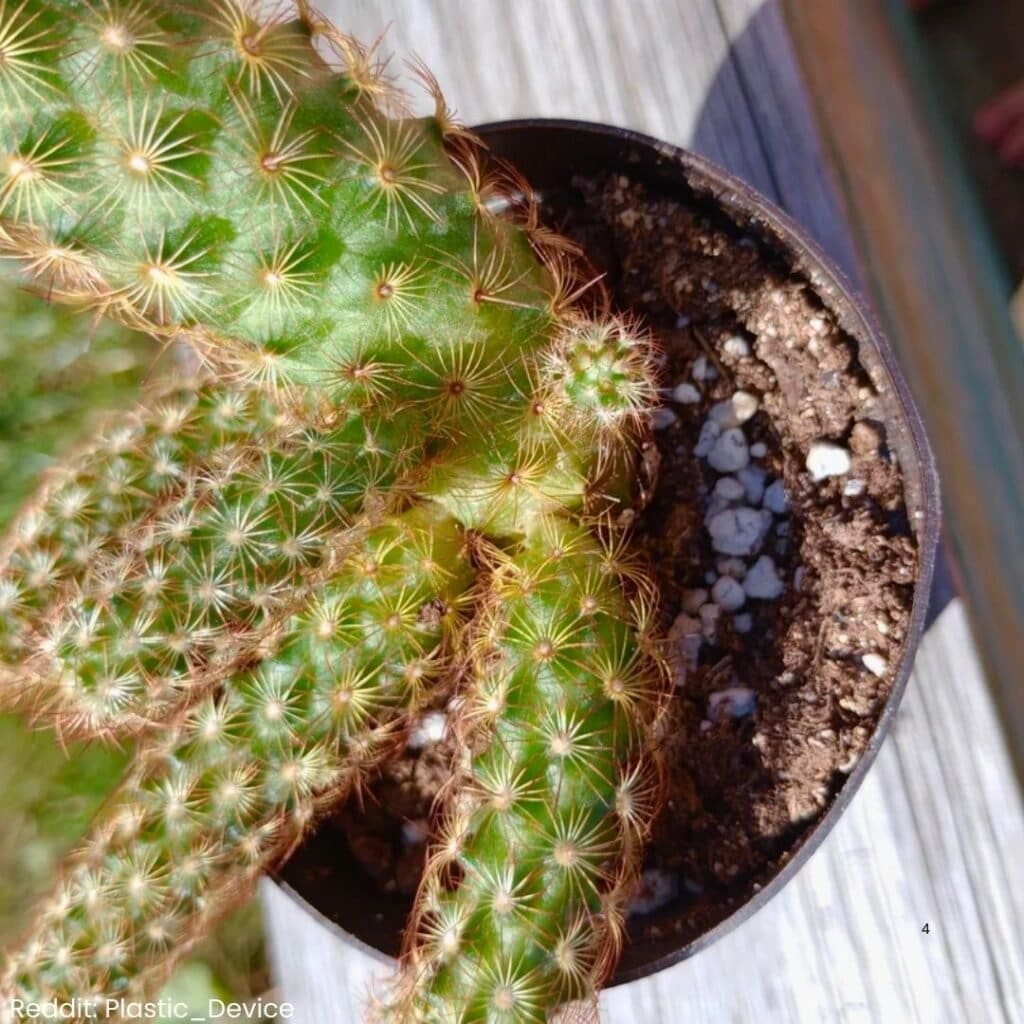
Taking care of my ladyfinger cactus year-round is like having a seasonal wardrobe. 🌵 Each season needs a little tweak here and there.
In spring, I give my cactus a fresh start by moving it outside to enjoy more sun. 😊
If you’ve been hiding indoors all winter, why deny your cactus some sunshine?
Don’t forget to water moderately as the weather warms up.
Summer is when my cactus thrives!
I water it slightly more often since the heat can dry out the soil pretty quickly.
Just like I grab a cold drink, the cactus needs some extra hydration. 💧
When autumn rolls around, I start to ease up on watering.
It’s like switching from beach towels to cozy sweaters.
My cactus still enjoys a good amount of sunlight, but less water helps it wind down for cooler days.
During winter, I give my ladyfinger cactus a break, almost like hibernating. 🌙
I move it indoors, near a bright window, and water very sparingly.
Have you ever noticed how plants love being cozy inside when it’s chilly outside? Let’s keep it snug!
Here’s a quick watering schedule to keep it simple:
| Season | Watering Frequency |
|---|---|
| Spring | Moderate |
| Summer | Slightly more |
| Autumn | Less frequent |
| Winter | Minimum |
Ever tried these tips for your own cactus? Share your thoughts below! 😊
Displaying Your Ladyfinger Cactus
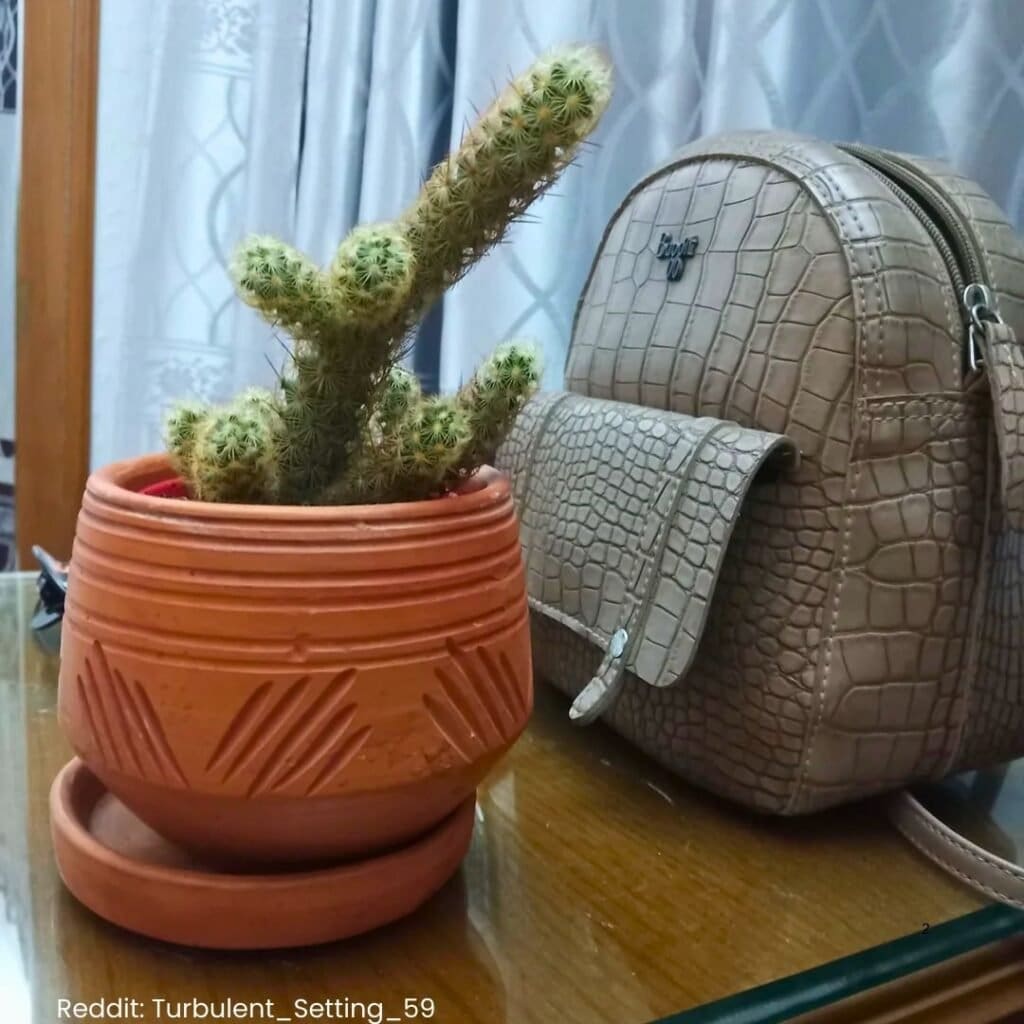
I love showing off my ladyfinger cactus because it adds so much charm to my space! 😊
This cactus thrives best when it’s placed in a spot with bright but indirect light. Think about a sunny windowsill or a well-lit room.
Don’t you think a cactus deserves a nice pot?
Choosing a colorful or patterned pot can really make your cactus pop. Just be sure it has drainage holes. No one likes soggy roots!
Tip: Grouping my ladyfinger cactus with other succulents or cacti creates an eye-catching display. It’s like having a mini desert garden indoors!
I sometimes wonder, should I hang it or place it on a shelf?
Both work great! Hanging planters add a unique touch, while shelves give it a comfy home.
The key is making sure it gets the right light from high up or tucked into a shelf.
Having a consistent temperature is important, too.
I’ve found that keeping the cactus away from cold drafts helps it stay healthy and happy.
Feel free to be creative!
Add small rocks or figurines around the base for extra flair.
It’s amazing how these little touches can make it stand out even more.
Ever thought of sharing your cactus’s journey online?
A series of photos showing its growth or arrangement ideas can be fun to share on Instagram or with friends. 📸
How do you style your ladyfinger cactus?
Safety and Precautions
Caring for the ladyfinger cactus can be an enjoyable experience, but it’s important to keep a few safety tips in mind. 🌵
Keep Out of Reach: If you have kids or pets, make sure your cactus is out of their reach. Little fingers and paws might find it too tempting, but a poke from the cactus isn’t fun for anyone.
Wear Gloves: Whenever I handle my cactus, I always wear gloves. It’s a small step to avoid those sharp spines. Do you have your own favorite pair of gardening gloves?
Be Mindful of Placement: Make sure it’s in a stable spot where it won’t accidentally get knocked over.
A cactus can be surprisingly heavy and messy when it falls. Plus, who wants to clean up broken pots and soil? Not this guy!
Spine Safety: If I ever get a spine stuck in my skin (it happens to the best of us), tweezers and sticky tape are my best friends. A quick pull or dab usually does the trick!
Stay safe while caring for your ladyfinger cactus. A little preparation goes a long way to avoid unexpected ouches.
Have you ever had a surprise encounter with a cactus? 🌿
Frequently Asked Questions
Caring for a ladyfinger cactus means providing the right light, water, and temperature. Let’s take a look at some common questions I get about keeping these little plants healthy and happy. 🌵
What are the best conditions for keeping a lady finger cactus healthy?
To keep your lady finger cactus thriving, place it where it can get bright sunlight.
I find that a south-facing window is perfect. 🌞
Water sparingly, letting the soil dry out between sessions.
Remember, they are drought-tolerant.
Keep the temperature around 65° to 85°F for best growth.
Why is my lady finger cactus turning yellow and how can I fix it?
If your cactus starts to yellow, it may be a sign of overwatering. Yikes!
Make sure the pot drains well and cut back on watering.
Another culprit could be lack of light. Try giving it a new spot with more sunshine.
If pests are the problem, a gentle spray of soapy water usually helps.
Can you guide me through the steps to properly propagate a lady finger cactus?
Propagating ladyfinger cacti is fun and easy! 😊
Take a cutting from a healthy stem and let it dry for a couple of days.
Once it’s ready, plant it in a pot with well-draining soil.
Keep the soil slightly moist until you see new growth.
Soon, you’ll have a whole family of cacti!
How can I encourage my lady finger cactus to produce flowers?
Flowers on a cactus? Yes, please! 💐
To encourage blooming, make sure to give them lots of light.
During the cooler months, reduce watering to mimic their natural cycle.
A little cactus fertilizer in the spring can give them a boost.
Be patient; they bloom when they’re ready, usually in the spring.
What are common reasons a lady finger cactus might die and how can I prevent them?
The biggest threats to your cactus are overwatering and pests.
Be cautious with your watering schedule, and check the soil before each session. 🌧️
Regularly inspect for pests like mealybugs. If you notice any, a bit of neem oil can help.
Healthy practices will keep your cactus happy and alive.
What is the average lifespan of a ladyfinger cactus?
With proper care, these delightful plants can live quite a long time, up to 10-15 years!
Imagine all the stories I’ll have to share with my cactus buddy. 😄
Keep up with their care, and you’ll have a loyal plant friend for years to come.
Recommended Garden Supplies
| Product Image | Our Recommended Gardening Supplies | Check Offers! |
|---|---|---|
Top Top
Top
Top
Top
Top
Top
Top
Top | rePotme Houseplant and Tropical Classic Potting Soil Mix | Check Offer On Amazon |
 Top
Top
Top
Top
Top
Top
Top
Top | Espoma Organic Indoor Plant Food | Check Offer On Amazon |
 Top
Top
Top
Top
Top
Top
Top
Top | GooingTop LED Grow Light 6000K Full Spectrum Clip Plant Growing Lamp | Check Offer On Amazon |
 Top
Top
Top
Top
Top
Top
Top
Top | Soil Moisture Meter | Check Offer On Amazon |
 Top
Top
Top
Top
Top
Top
Top
Top | Govee Hygrometer Thermometer, Bluetooth Enabled! | Check Offer On Amazon |
 Top
Top | LEVOIT Humidifiers for Large Room(Best For Plants) | Check Offer On Amazon |
 Top
Top
Top
Top
Top
Top
Top
Top | Upgraded DIY Automatic Drip Irrigation Kit, 15 Potted Houseplants Support | Check Offer On Amazon |
 Top
Top
Top
Top
Top
Top
Top
Top | Stainless Steel Heavy Duty Gardening Tool Set | Check Offer On Amazon |
 Top
Top
Top
Top
Top
Top
Top
Top | Bonide Insecticidal Soap | Check Offer On Amazon |
 Top
Top
Top
Top
Top
Top
Top
Top | Bonide 32 oz Spray Neem Oil for Organic Gardening | Check Offer On Amazon |
 Top
Top
Top
Top
Top
Top
Top
Top | Garden Safe Fungicide | Check Offer On Amazon |



